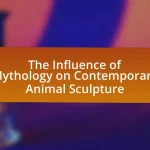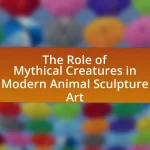The article focuses on selecting the perfect wildlife sculpture for your home, emphasizing key considerations such as size, material, style, and emotional impact. It outlines how to determine the right style based on existing decor, explores various sculpture styles including realistic and abstract, and discusses the significance of material choice for durability and aesthetics. Additionally, the article provides practical tips for measuring space, choosing color schemes, and maintaining sculptures, while also highlighting the importance of finding reputable artists and verifying authenticity. Overall, it serves as a comprehensive guide for enhancing home decor with wildlife sculptures that reflect personal taste and values.

What Should You Consider When Choosing a Wildlife Sculpture for Your Home?
When choosing a wildlife sculpture for your home, consider the size, material, style, and the message or emotion you want to convey. The size should complement your space, ensuring the sculpture fits well without overwhelming the area. Materials like bronze, wood, or stone each offer different aesthetics and durability, influencing the overall look and feel of your home. The style should align with your existing decor, whether it’s modern, rustic, or traditional, to create a cohesive environment. Additionally, the emotional impact of the sculpture can enhance the ambiance; for instance, a serene animal figure may evoke tranquility, while a dynamic pose can inspire energy. These factors collectively ensure that the wildlife sculpture not only enhances your home’s aesthetic but also resonates with your personal taste and values.
How do you determine the right style of wildlife sculpture for your space?
To determine the right style of wildlife sculpture for your space, assess the existing decor and the intended ambiance of the area. The style of the sculpture should complement the overall aesthetic, whether it is modern, rustic, or traditional. For instance, a sleek, abstract sculpture may suit a contemporary setting, while a detailed, realistic piece may enhance a more classic environment. Additionally, consider the size and scale of the sculpture in relation to the space; a large sculpture can serve as a focal point, while smaller pieces can be used for subtle accents. Ultimately, the right style will harmonize with your interior design and reflect your personal taste.
What are the different styles of wildlife sculptures available?
Different styles of wildlife sculptures include realistic, abstract, stylized, and kinetic. Realistic sculptures aim to accurately depict animals in their natural form, often using materials like bronze or stone to capture intricate details. Abstract sculptures focus on conveying the essence or spirit of wildlife through simplified shapes and forms, allowing for personal interpretation. Stylized sculptures incorporate artistic elements that emphasize certain features of the animals, often blending realism with artistic expression. Kinetic sculptures introduce movement, using mechanisms to create dynamic representations of wildlife. Each style offers unique aesthetic qualities, catering to diverse tastes and interior design themes.
How does the style of your home influence your choice of sculpture?
The style of your home significantly influences your choice of sculpture by dictating the aesthetic harmony and thematic coherence of your interior or exterior spaces. For instance, a modern home with clean lines and minimalistic decor may benefit from abstract or contemporary sculptures that complement its sleek design, while a traditional home might be better suited for classic or realistic wildlife sculptures that resonate with its historical elements. This alignment ensures that the sculpture enhances the overall ambiance rather than clashes with the existing decor, thereby creating a cohesive visual narrative.
What materials are commonly used in wildlife sculptures?
Common materials used in wildlife sculptures include bronze, stone, wood, and resin. Bronze is favored for its durability and ability to capture fine details, making it a popular choice among sculptors. Stone, such as marble or granite, offers a timeless quality and is often used for larger, more permanent pieces. Wood provides a natural aesthetic and can be intricately carved to depict various wildlife forms. Resin is lightweight and versatile, allowing for detailed reproductions at a lower cost. These materials are chosen based on their unique properties, which enhance the artistic representation of wildlife.
How does the material affect the durability of the sculpture?
The material significantly affects the durability of a sculpture by determining its resistance to environmental factors and physical wear. For instance, materials like bronze and stone are known for their longevity and ability to withstand weather conditions, while softer materials such as wood or clay may deteriorate more quickly when exposed to moisture or temperature fluctuations. Historical evidence shows that bronze sculptures, such as those from ancient Greece, have survived for centuries due to their corrosion resistance, highlighting the importance of material choice in ensuring a sculpture’s lasting presence.
What are the aesthetic differences between various materials?
The aesthetic differences between various materials used in wildlife sculptures include texture, color, and form. For instance, bronze offers a classic, timeless look with a smooth surface that can develop a patina over time, enhancing its visual appeal. Wood, on the other hand, provides a warm, organic feel with natural grain patterns that vary significantly between species, contributing to a unique character in each piece. Stone, such as marble or granite, presents a polished, elegant appearance with a cool touch and intricate veining, while resin can mimic other materials and allows for vibrant colors and detailed finishes. Each material’s inherent properties influence the overall aesthetic, making the choice crucial for complementing home decor.
Why is the size of the sculpture important?
The size of the sculpture is important because it directly influences the visual impact and spatial harmony within a home environment. A larger sculpture can serve as a focal point, drawing attention and creating a sense of grandeur, while a smaller piece may complement existing decor without overwhelming the space. For instance, a study by the American Society of Interior Designers indicates that scale is a critical factor in design, as it affects how objects relate to one another and to the overall room dimensions. Therefore, selecting the appropriate size ensures that the sculpture enhances the aesthetic appeal and fits seamlessly into the intended space.
How do you measure the space for your wildlife sculpture?
To measure the space for your wildlife sculpture, first determine the dimensions of the area where the sculpture will be placed, including height, width, and depth. Use a tape measure to accurately assess the available space, ensuring to account for any surrounding furniture or obstacles that may affect the placement. For instance, if the sculpture is intended for a corner, measure both walls to confirm the sculpture will fit without obstruction. Additionally, consider the visual impact by standing at various distances to gauge how the sculpture will appear in the space. This method ensures that the sculpture complements the environment and maintains a balanced aesthetic.
What are the implications of choosing a large versus a small sculpture?
Choosing a large sculpture typically implies a bold statement and a focal point in a space, while a small sculpture suggests subtlety and versatility in placement. Large sculptures can dominate a room, making them suitable for open areas or outdoor settings, where they can be appreciated from a distance. In contrast, small sculptures can fit into various nooks and crannies, allowing for more intimate displays and easier integration into existing decor. The choice between large and small also affects the viewer’s interaction; large sculptures invite admiration from afar, while small sculptures encourage closer inspection and personal connection.
How Can You Ensure the Wildlife Sculpture Fits Your Home’s Aesthetic?
To ensure the wildlife sculpture fits your home’s aesthetic, first assess your existing decor style, such as modern, rustic, or traditional. This evaluation allows you to select a sculpture that complements the overall theme and color palette of your space. For example, a sleek metal sculpture may suit a contemporary home, while a wooden piece could enhance a rustic setting. Additionally, consider the size and scale of the sculpture in relation to your room; a large piece can serve as a focal point, while smaller sculptures can accentuate existing decor. Matching materials and colors with your furnishings further reinforces cohesion in your aesthetic.
What color schemes should you consider when selecting a sculpture?
When selecting a sculpture, consider color schemes that complement your home decor and the sculpture’s intended emotional impact. Neutral tones, such as whites, grays, and beiges, can create a calming effect and blend seamlessly with various interior styles. Bold colors, like reds or blues, can serve as focal points and evoke strong emotions, making them suitable for statement pieces. Additionally, earthy tones, including greens and browns, resonate well with wildlife themes, enhancing the natural aesthetic. Research indicates that color can influence perception and mood, making thoughtful color selection crucial in art placement.
How do colors in the sculpture complement your existing decor?
The colors in the sculpture enhance the existing decor by creating a harmonious visual balance. For instance, if the decor features earthy tones, a sculpture with similar hues can seamlessly integrate into the space, reinforcing the overall aesthetic. Additionally, contrasting colors in the sculpture can draw attention and serve as a focal point, enriching the decor without overwhelming it. This principle is supported by color theory, which emphasizes that complementary colors can enhance the visual appeal of a room, making it more inviting and cohesive.
What are the best color combinations for wildlife sculptures?
The best color combinations for wildlife sculptures include earthy tones like browns and greens, which mimic natural habitats, and vibrant colors such as blues and oranges that can highlight specific features of the animals. Earthy tones provide a realistic representation, enhancing the sculpture’s connection to nature, while vibrant colors can create visual interest and draw attention to the piece. For example, a sculpture of a bird may use a combination of bright blue and yellow to reflect its plumage, making it more striking. These combinations not only enhance aesthetic appeal but also resonate with the themes of wildlife and nature, making them effective choices for home decor.
How does the theme of the sculpture relate to your home environment?
The theme of the sculpture relates to the home environment by enhancing the natural aesthetic and creating a connection to wildlife. For instance, a sculpture depicting local fauna can reflect the surrounding landscape and promote a sense of harmony with nature. This connection is supported by studies showing that incorporating natural elements in home decor can improve well-being and reduce stress, as evidenced by research from the University of Queensland, which found that nature-themed art positively influences mood and relaxation.
What themes are popular in wildlife sculptures?
Popular themes in wildlife sculptures include realism, abstraction, and conservation. Realism focuses on accurately depicting animals in their natural habitats, often showcasing intricate details and lifelike poses. Abstraction emphasizes form and movement, allowing artists to interpret wildlife in a more stylized manner. Conservation themes highlight endangered species and environmental issues, aiming to raise awareness through artistic representation. These themes resonate with audiences and reflect the diverse ways artists engage with nature and wildlife.
How can you choose a theme that resonates with your personal style?
To choose a theme that resonates with your personal style, first identify your preferences in color, texture, and subject matter. This involves reflecting on your existing decor and the emotions you wish to evoke in your space. For instance, if you prefer a serene atmosphere, consider themes that incorporate soft colors and natural elements. Research shows that personal style is often influenced by individual experiences and cultural backgrounds, which can guide your theme selection. By aligning your chosen theme with your personal tastes and the overall aesthetic of your home, you ensure that the wildlife sculptures you select will enhance your living environment and reflect your unique identity.

What Practical Tips Can Help You Choose the Perfect Wildlife Sculpture?
To choose the perfect wildlife sculpture, consider the size, material, and style that best fits your space and aesthetic. Selecting the right size ensures the sculpture complements your environment without overwhelming it; for instance, a large piece can serve as a focal point in a spacious room, while smaller sculptures work well on shelves or tables. The material, whether bronze, wood, or stone, affects both the visual appeal and durability; bronze sculptures, for example, are known for their longevity and classic look. Additionally, the style should resonate with your personal taste and the overall decor of your home; realistic representations may appeal to nature lovers, while abstract designs can add a modern touch. These considerations are essential for making an informed decision that enhances your living space.
How can you find reputable artists or sources for wildlife sculptures?
To find reputable artists or sources for wildlife sculptures, start by researching established galleries and art shows that specialize in wildlife art. These venues often showcase the work of recognized artists and provide a platform for emerging talent. Additionally, online platforms such as Artsy and Saatchi Art feature curated collections from verified artists, ensuring quality and authenticity. According to the American Art Dealers Association, reputable galleries typically have a vetting process for artists, which adds a layer of credibility. Engaging with local art communities and attending wildlife art exhibitions can also lead to discovering talented artists.
What should you look for in an artist’s portfolio?
When evaluating an artist’s portfolio, you should look for a diverse range of work that showcases their skills and style. A well-rounded portfolio typically includes various pieces that demonstrate the artist’s ability to capture different subjects, techniques, and mediums. Additionally, the portfolio should reflect a consistent quality of craftsmanship, indicating the artist’s dedication to their craft. For instance, if the artist specializes in wildlife sculpture, their portfolio should include multiple examples of animal representations, highlighting their understanding of anatomy, texture, and movement. This diversity and quality provide insight into the artist’s versatility and expertise, making it easier to assess their suitability for creating a wildlife sculpture for your home.
How do you verify the authenticity of a wildlife sculpture?
To verify the authenticity of a wildlife sculpture, examine the artist’s signature and provenance documentation. The artist’s signature should be consistent with known examples, and provenance documentation should trace the sculpture’s ownership history, confirming its legitimacy. Additionally, consult experts or appraisers who specialize in wildlife art, as they can provide insights based on their knowledge of the artist’s techniques and materials used. Authentic wildlife sculptures often utilize specific materials, such as bronze or stone, which can also be analyzed for authenticity through scientific methods like X-ray fluorescence or thermoluminescence dating.
What are the best practices for maintaining your wildlife sculpture?
To maintain your wildlife sculpture effectively, regularly clean it with a soft, dry cloth to remove dust and debris. This practice prevents buildup that can damage the surface over time. Additionally, avoid using harsh chemicals or abrasive materials, as they can scratch or degrade the sculpture’s finish. For outdoor sculptures, applying a protective sealant can help shield against weather elements, extending the lifespan of the piece. Regular inspections for signs of wear or damage allow for timely repairs, ensuring the sculpture remains in optimal condition.
How can you protect your sculpture from environmental damage?
To protect your sculpture from environmental damage, apply a weather-resistant sealant specifically designed for the material of the sculpture. This sealant creates a barrier against moisture, UV rays, and pollutants, which can degrade the sculpture over time. For instance, sculptures made of stone or metal benefit from a clear acrylic or polyurethane sealant that prevents rust and corrosion, while wooden sculptures require a penetrating oil or varnish to guard against rot and fading. Regular maintenance, such as cleaning and reapplying the sealant as needed, further enhances the sculpture’s durability against environmental factors.
What cleaning methods are safe for different materials used in sculptures?
Safe cleaning methods for different materials used in sculptures vary based on the material composition. For stone sculptures, using a soft brush and water is effective, as harsh chemicals can damage the surface. Metal sculptures can be cleaned with a mild soap solution and a soft cloth to avoid scratching. Wooden sculptures benefit from a gentle dusting and occasional application of a wood conditioner to maintain their finish. For bronze sculptures, a mixture of vinegar and water can help remove tarnish without causing harm. Each method is tailored to preserve the integrity of the specific material while ensuring cleanliness.


